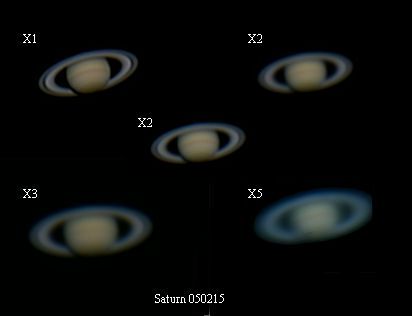

 Click on the image to see full-scale images.
Click on the image to see full-scale images.
Because of the wave nature of light, a telescope cannot resolve two stars whose separation is less than a limit called the
Dawes Limit. This limit is related to the aperture of the telescope and given by the relationship
R = 115.8/D in which R is the separation in arc-seconds, and D is the diameter of the
telescopes objective in millimetres. This is a theoretical limit and, with modern processing techniques involving the
stacking of many individual frames, it is possible to resolve detail somewhat smaller than the Dawes Limit, but
it serves as a good guide to what is possible.
A CCD camera imposes another limit on the resolution of an image. The individual pixels on the chip are a finite distance
apart, so no detail smaller than this can be resolved by the camera. For the CCD chip used in the Philips cameras
that I use, this separation is 5.6 microns. Dividing this by the focal length of the telescope (and a little
trigonometry) gives another limit on the detail that can be resolved.
In the case of my LX200, the aperture is 254 mm so it's Dawes limit is 0.45 seconds of arc. Its focal length is
2500 mm, which gives a resolution for the camera of 0.46 seconds of arc. These two figures match perfectly, so
with my ToUcam at prime focus, it can just about resolve as much as the telescope can. However, it is generally
agreed that one should ideally use a resolution at the camera of about 1.5 or 2 times the Dawes limit, so use of my
X2 adaptor lens is appropriate, but the barlows were a complete waste of money.
All this seems contrary to intuition. One would have thought that the bigger the image on the camera, the better
the final image should be, even if it is sampling at a resolution far in excess of what the telescope can provide;
one would have thought that stacking and reducing the size again really would produce the best image the telescope can provide.
My experiment does not seem to confirm that intuition. Four further points have to be borne in mind.
Firstly, good focusing seems to be more difficult as the focal length increases, so the image may be a trice out of focus.
Secondly, the quality of the lens will be important. It cannot improve the image, only degrade it. Users of pure
reflectors need to be aware that a lens may introduce chromatic aberrations.
Thirdly, there will be a significant dimming of the image. A X2 lens reduces the intensity of the light by a factor
of four, which will require higher gain and create more noise.
Fourthly, any movement of the telescope will be magnified as much as the image. This may itself result in blurred images.
A fifth point should also be made. The cleanliness of the CCD and any components near it will be much more
critical as the focal length increases. At longer focal lengths, the cone of light converging on the CCD is narrower
and dust particles throw longer shadows.